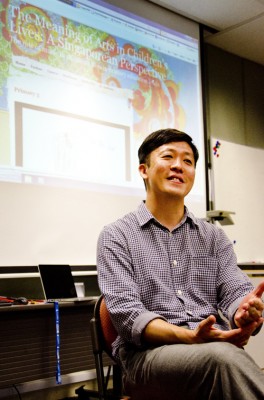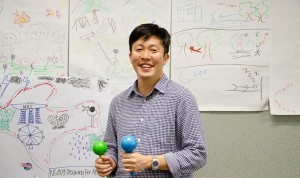Why Singapore’s English Teachers Should Embrace Singlish, Not Fight It
Is it time for Singaporean educators to embrace Singlish as a legitimate learning tool? What the Research […]
Read More
What does music mean to your young pupils? To find out, try asking them to draw! You’ll be surprised to discover more about what they think of music and how they want to learn it in school.
Music affects all of us differently. This is true of children, too. The way they connect to and make sense of music also differs, depending on whether they are in school or at home.
That’s what sparked an idea in Dr Lum Chee Hoo, an Assistant Professor with NIE’s Visual and Performing Arts Academic Group, to look at the meaning of music in children’s lives.
“I have always been interested in examining the meaning of the arts in children’s lives,” he explains.
As children grow up, how does music influence them as individuals? And what can teachers do to engage pupils in their music lessons by reflecting on their pedagogy and practices?
 To find out, Chee Hoo posed several questions about music to pupils from five primary schools. Questions like: “When you hear the word ‘music’, what comes to your mind?” And, “How do you do ‘music’?”
To find out, Chee Hoo posed several questions about music to pupils from five primary schools. Questions like: “When you hear the word ‘music’, what comes to your mind?” And, “How do you do ‘music’?”
But asking pupils to just write down their responses may elicit short or vague answers. And being young, they may also not be able to find the right words to describe their feelings towards music.
So he also asked the children to draw out a picture of what music means to them and its relationship with their daily lives, to get a clearer picture of their views.
“It is interesting because thinking about music and how it manifests to a bigger piece of painting will tell us what is significant.”
True enough, from the children’s responses and drawings, the research team and the music teachers realized that every child saw music differently.
“Students drew an mp3 player, instruments such as the piano, or even performing on the stage. These can allow teachers to know their pupils at a deeper level in terms of their preferences for musical activities,” notes Chee Hoo.
Through the drawings, teachers could see what current influences the children were exposed to. For instance, drawings of devices such as mp3 players showed that technology plays a big part in pupils’ involvement with music.
It’s also a quick way of looking at what happens in the classroom. For example, in some schools, music notes and staff often showed up in the children’s drawings.
It made music teachers realize that the emphasis they had placed on the learning of musical notes, something they had done unconsciously, had an impact on how their pupils viewed music.
Putting the children’s responses into a “wordle”, a visual representation of responses that appear most frequently in the research, also gave the music teachers an immediate sense of what was more significant in pupils’ responses about music.
As Chee Hoo puts it, it’s a good chance to see “what is in the children’s heads”.
“In a way, it allows educators to really see how music relates to children in their daily lives and ascertain their strengths.”
Chee Hoo hopes his findings can facilitate reflection by music teachers on how they are teaching music.
“The idea is for teachers to think about their programmes and what they can do to further the creative spaces for their pupils,” he explains. “Only the teacher can decipher those possibilities.”
 Although the research team didn’t get to talk to the children about their drawings, Chee Hoo believes these drawings can allow for conversations about music to happen between teachers and children.
Although the research team didn’t get to talk to the children about their drawings, Chee Hoo believes these drawings can allow for conversations about music to happen between teachers and children.
With the current emphasis on developing 21st century skills, music class isn’t just about learning to play an instrument or sing a song. The music curriculum plays an important part in helping pupils learn to express themselves creatively and critically.
“It is a skill that we need to develop, and the arts provides for the ambiguity and for children to recognize that it is not a black-and-white world. It is about how things shift in and out,” Chee Hoo explains. “That is a valuable skill unique to arts education.”
That should be music to the teachers’ ears.